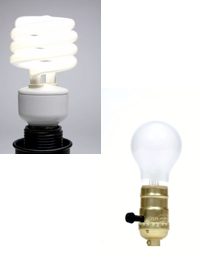
In 2007, President George W. Bush signed into law an energy bill that included an amendment which banned the incandescent light bulb. The ban is scheduled to go into effect on January 1, 2014. Since the signing of the law, a number of Republicans have targeted the bill as another example of government overreach. One such Republican is Minnesota Representative Michele Bachmann, who introduced H.R.5616 in 2008 to blunt the law passed in the prior year.
The bill, entitled the Light Bulb Freedom of Choice Act, reads:
Light Bulb Freedom of Choice Act Amends the Energy Independence and Security Act of 2007 to repeal provisions concerning energy efficiency standards for general service incandescent lamps, rough service lamps, other designated lamps, and incandescent reflector lamps unless the Comptroller General has transmitted to Congress within six months after this Acts enactment a report that finds that: (1) consumers will obtain a net savings, in terms of dollars spent on monthly electric bills and expenses for new light fixtures to accommodate the use of the light bulbs required by such provisions, compared to dollars spent before their enactment; (2) the phase-out of incandescent light bulbs required by such provisions will reduce overall carbon dioxide emissions by 20% in the United States by 2025; and (3) such phase-out will not pose any health risks, including risks associated with mercury containment in certain light bulbs, to consumers or the general public, including health risks with respect to hospitals, schools, day care centers, mental health facilities, and nursing homes.
Requires the report to include monthly and yearly projections of expenses for electric bills and new light fixtures for January 1, 2012, through December 31, 2017.
Two years later, Bachmann has taken the opportunity to reintroduce the bill to the Republican majority in the House of Representatives. The 2011 version of the bill is listed as H.R. 849. Of the new bill, The Blaze reports:
[H.R.849] targets the elimination of two specific parts of the Energy Independence and Security Act of 2007 dealing with energy-efficiency standards for incandescent and fluorescent bulbs and labeling standards. Bachmanns bill would permit the 2007 standards to survive if the comptroller general is able to prove the estimated savings to consumers, reduced carbon-dioxide emissions and that the presence of mercury in the new bulbs poses no health risks to consumers.
Of all the provisions, the one that indicates that proof must be presented to show that the presence of mercury does not pose a health risk is likely the most difficult. In particular, mercury is especially harmful for children and fetuses.
John Skinner, executive director of the Solid Waste Association of North America, explains the problem with the presence of mercury in the compact fluorescent light bulbs (CFLs) that are being promoted by the federal government.
The problem with the bulbs is that theyll break before they get to the landfill. Theyll break in containers, or theyll break in a dumpster or theyll break in the trucks. Workers may be exposed to very high levels of mercury when that happens.
Skinner adds that if the bulbs were broken near homes, they had the potential to contaminate the soil.
There is no better evidence of the potential dangers of the CFLs than the following lengthy instructions for the cleanup of broken CFLs in the home provided by the Environmental Protection Agency:
Before Cleanup:
- Have people and pets leave the room, and avoid the breakage area on the way out.
- Open a window or door to the outdoors and leave the room for 5-10 minutes
- Shut off the central forced-air heating/air conditioning (H&AC) system, if you have one.
- Collect materials you will need to clean up the broken bulb:
- Stiff paper or cardboard
- Sticky tape (e.g., duct tape)
- Damp paper towels or disposable wet wipes (for hard surfaces)
- Glass jar with a metal lid (such as a canning jar) or a sealable plastic bag(s)
Cleanup Steps for Hard Surfaces:
- Carefully scoop up glass fragments and powder using stiff paper or cardboard and place debris and paper/cardboard in a glass jar with a metal lid. If a glass jar is not available, use a sealable plastic bag. (NOTE: Since a plastic bag will not prevent the mercury vapor from escaping, remove the plastic bag(s) from the home after cleanup.)
- Use sticky tape, such as duct tape, to pick up any remaining small glass fragments and powder. Place the used tape in the glass jar or plastic bag.
- Wipe the area clean with damp paper towels or disposable wet wipes. Place the towels in the glass jar or plastic bag.
- Vacuuming of hard surfaces during cleanup is not recommended unless broken glass remains after all other cleanup steps have been taken. [NOTE: It is possible that vacuuming could spread mercury-containing powder or mercury vapor, although available information on this problem is limited.] If vacuuming is needed to ensure removal of all broken glass, keep the following tips in mind:
- Keep a window or door to the outdoors open;
- Vacuum the area where the bulb was broken using the vacuum hose, if available; and
- Remove the vacuum bag (or empty and wipe the canister) and seal the bag/vacuum debris, and any materials used to clean the vacuum, in a plastic bag.
- Promptly place all bulb debris and cleanup materials, including vacuum cleaner bags, outdoors in a trash container or protected area until materials can be disposed of properly.
- Check with your local or state government about disposal requirements in your area. Some states and communities require fluorescent bulbs (broken or unbroken) be taken to a local recycling center.
- Wash your hands with soap and water after disposing of the jars or plastic bags containing bulb debris and cleanup materials.
- Continue to air out the room where the bulb was broken and leave the H&AC system shut off, as practical, for several hours.
Cleanup Steps for Carpeting or Rugs
- Carefully scoop up glass fragments and powder using stiff paper or cardboard and place debris and paper/cardboard in a glass jar with a metal lid. If a glass jar is not available, use a sealable plastic bag. (NOTE: Since a plastic bag will not prevent the mercury vapor from escaping, remove the plastic bag(s) from the home after cleanup.)
- Use sticky tape, such as duct tape, to pick up any remaining small glass fragments and powder. Place the used tape in the glass jar or plastic bag.
- Vacuuming of carpeting or rugs during cleanup is not recommended unless broken glass remains after all other cleanup steps have been taken. [NOTE: It is possible that vacuuming could spread mercury-containing powder or mercury vapor, although available information on this problem is limited.] If vacuuming is needed to ensure removal of all broken glass, keep the following tips in mind:
- Keep a window or door to the outdoors open;
- Vacuum the area where the bulb was broken using the vacuum hose, if available, and
- Remove the vacuum bag (or empty and wipe the canister) and seal the bag/vacuum debris, and any materials used to clean the vacuum, in a plastic bag.
- Promptly place all bulb debris and cleanup materials, including vacuum cleaner bags, outdoors in a trash container or protected area until materials can be disposed of properly.
- Check with your local or state government about disposal requirements in your area. Some states and communities require fluorescent bulbs (broken or unbroken) be taken to a local recycling center.
- Wash your hands with soap and water after disposing of the jars or plastic bags containing bulb debris and cleanup materials.
- Continue to air out the room where the bulb was broken and leave the H&AC system shut off, as practical, for several hours.
Future Cleaning of Carpeting or Rugs: Air Out the Room During and After Vacuuming
- The next several times you vacuum the rug or carpet, shut off the H&AC system if you have one, close the doors to other rooms, and open a window or door to the outside before vacuuming. Change the vacuum bag after each use in this area.
- After vacuuming is completed, keep the H&AC system shut off and the window or door to the outside open, as practical, for several hours.
The convoluted instructions sort of make it difficult to understand why exactly the government is promoting the use of the CFLs in the first place. Perhaps that is the reason Bachmann said the following when introducing her bill:
The government has no business telling an individual what kind of light bulb to buy.
Bachmanns bill is being co-sponsored by Representatives Ron Paul and Ted Poe of Texas, as well as Paul Broun of Georgia and Doug Lamborn of Colorado.




